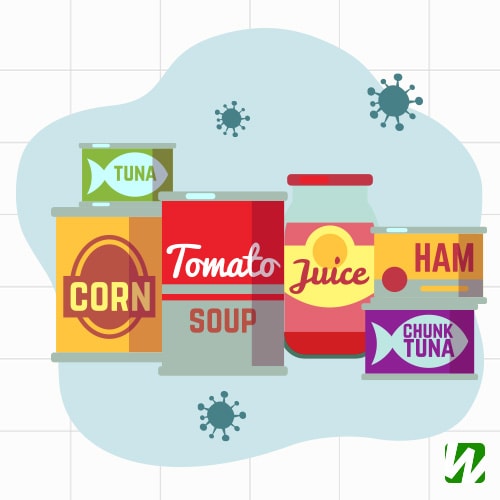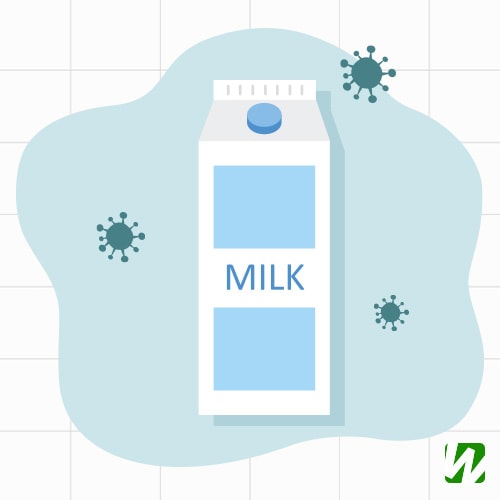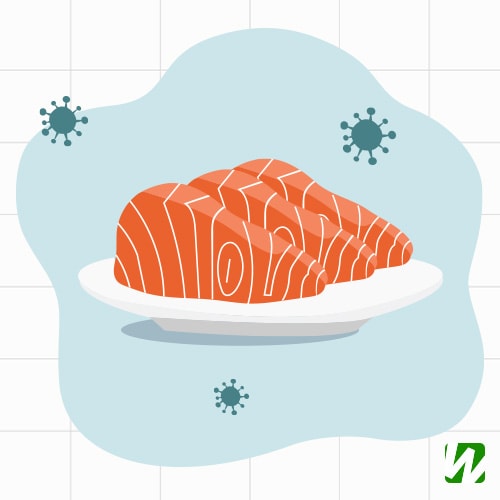
Foodborne illnesses pose a serious threat to both the reputation and operation of any foodservice establishment. Each year, tens of millions of people in the United States contract some kind of foodborne illness, and symptoms can range from mild discomfort to severe conditions requiring medical attention. Every foodservice operation, whether a restaurant, food truck, or concession stand, must prioritize food safety to minimize the spread of these illnesses. To effectively address the risk of foodborne illness, we've compiled a list of the types you might encounter, the foods they are typically associated with, and the symptoms they may cause.
Foodborne Illness List
While there are countless organisms and strains of bacteria that can cause foodborne illness, some stand out above the rest. Below, we'll investigate the most common, recognizable, and serious foodborne illnesses to help you embrace food safety.
1. Norovirus

Norovirus, also known as viral gastroenteritis or winter diarrhea, is a highly contagious virus and the leading cause of vomiting and diarrhea in the United States. It is spread through the fecal-oral route, and the most common sources of contamination include raw produce, contaminated drinking water, uncooked foods, shellfish from contaminated water, and cooked foods that are not reheated after contact with an infected food handler. Symptoms of Norovirus include nausea, vomiting, abdominal cramps, diarrhea, fever, and headaches. While diarrhea is more prevalent in adults, vomiting is more common in children.
The most critical step in preventing Norovirus outbreaks is ensuring that all employees and food handlers follow proper handwashing guidelines, especially after using the bathroom. Additionally, food handlers should avoid bare-hand contact with ready-to-eat foods, and all food contact surfaces must be thoroughly cleaned. Any surface in your facility that has come into contact with vomit or diarrhea should be promptly cleaned and disinfected. Food handlers displaying symptoms of Norovirus should not be allowed contact with food to prevent further contamination, and you must thoroughly wash all produce and source it from reputable suppliers.
- Origin: Noroviruses
- Incubation period: 12-48 hours
- Duration: Up to 3 days
2. Salmonella

Salmonella is a well-known culprit when it comes to foodborne illness. This type of food poisoning, known as salmonellosis, is caused by the bacteria salmonella. The transmission of this harmful bacteria typically occurs through the fecal-oral route, and symptoms include diarrhea, vomiting, fever, and abdominal cramps. Common sources of salmonella contamination include raw eggs, beef, poultry, pork, unpasteurized milk or juice, cheese, contaminated raw produce, nuts, and sprouts.
To prevent the spread of salmonella in a commercial food service setting, ensure all employees adhere to proper handwashing procedures to minimize the risk of cross-contamination. When handling raw or high-risk foods, take extra precautions to prevent the spread of bacteria. Always purchase food items from reputable suppliers to reduce the chances of contamination before they even reach your kitchen.
- Origin: Salmonella
- Incubation period: 6-48 hours
- Duration: 4-7 days
3. E. Coli

E. coli is a bacterial infection caused by Escherichia coli bacteria-producing toxins and is typically transmitted through the fecal-oral route. One of the most prevalent methods of spreading E. coli is through food handlers who do not adhere to proper workplace hygiene practices. This bacterium can also be found in undercooked ground beef, unpasteurized dairy products, and raw produce. When infected with E. coli, individuals may experience severe diarrhea, abdominal cramps, and vomiting. Some may also have a slight fever.
To reduce the risk of an outbreak, ensure foods are cooked to the correct internal temperature and held at the appropriate temperature to prevent bacterial growth. Purchase produce from reputable vendors who follow stringent food safety practices. Additionally, all employees and food handlers must wash their hands thoroughly before, during, and after preparing food, as well as after using the restroom.
- Origin: E. coli producing toxin
- Incubation period: Typically 1-3 days, but can be up to 10
- Duration: 3-7 days
4. Hepatitis A

Hepatitis A is a highly contagious liver infection. It spreads through the fecal-oral route, especially in contaminated water, shellfish that are raw or undercooked and harvested in contaminated water, raw produce, uncooked foods, and cooked foods that haven’t been reheated after coming into contact with an infected food handler. Common symptoms include diarrhea, dark urine, light-colored stools, jaundice, flu-like symptoms such as fever and fatigue, nausea, joint pain, abdominal pain, and loss of appetite.
Most people are administered a two-part Hepatitis A vaccine between 12-24 months of age to provide immunity. To prevent the spread of Hepatitis A in your establishment, take extra care when serving raw oysters or shellfish, always order shellfish and produce from reputable, certified sources, ensure all employees follow proper workplace hand washing and hygiene practices, and uphold strict illness reporting guidelines by sending infected food handlers home immediately.
- Origin: Hepatitis A
- Incubation period: 15-50 days, 28 days average
- Duration: 2 weeks-3 months
5. B. Cereus Food Poisoning

Bacillus cereus food poisoning, often shortened as B. cereus food poisoning, is commonly associated with meat, stews, gravies, sauces, or soups left out at room temperature for extended periods. When these foods are not properly stored, it creates the perfect conditions for Bacillus cereus bacteria to grow and multiply. Symptoms can vary, but they typically include watery diarrhea, abdominal cramps, nausea, and vomiting.
To prevent B. cereus food poisoning, foods must be kept out of the temperature danger zone for holding or serving. For foods that you plan to store, it is recommended to keep them in a shallow container and refrigerate them as soon as possible to inhibit the growth of harmful bacteria like Bacillus cereus.
- Origin: Bacillus cereus
- Incubation period: 10-16 hours
- Duration: 24-48 hours
6. Campylobacteriosis

Campylobacteriosis is a foodborne illness caused by the Campylobacter bacteria. It is commonly contracted by consuming unpasteurized dairy products like milk, raw or undercooked poultry, shellfish, or contaminated water. Signs and symptoms of Campylobacteriosis typically include cramps, diarrhea, fever, and vomiting. In severe cases, diarrhea may be bloody.
To reduce the risk of Campylobacteriosis in your commercial kitchen or food establishment, avoid serving or using raw milk and ensure any water used in food preparation is properly treated. Always follow food safety guidelines, especially when handling and cooking poultry. When working with seafood, hold raw shellfish at the correct temperature to prevent bacterial growth and contamination.
- Origin: Campylobacter jejuni
- Incubation period: 2-5 days
- Duration: 2-10 days
7. Botulism

Botulism is a serious foodborne illness caused by Clostridium botulinum. This toxin-producing bacterium can be found in improperly canned or preserved foods, particularly in canned vegetables, fermented fish, and baked potatoes wrapped in aluminum foil. Symptoms include double vision, blurred vision, drooping eyelids, slurred speech, difficulty swallowing, dry mouth, and muscle weakness. In severe cases, botulism can lead to respiratory failure and even death.
To reduce the risk of botulism, follow proper canning instructions when preserving foods. Additionally, always ensure that seafood and potatoes are purchased from reputable suppliers who adhere to food safety regulations.
- Origin: Clostridium botulinum
- Incubation period: 12-72 hours
- Duration: Variable
8. Perfringens

Perfringens stems from the bacteria Clostridium perfringens, which is commonly found in beef, poultry, gravy, dried or precooked foods, and foods that have been time or temperature abused. Individuals who consume food contaminated with Clostridium perfringens may experience intense abdominal cramps and watery diarrhea. Perfringens food poisoning typically does not cause a fever or vomiting.
To prevent Perfringens food poisoning, use a food thermometer to ensure that all foods are cooked to a safe internal temperature and keep foods out of the temperature danger zone during holding or storage. When storing large batches of food, such as soups, divide them into smaller, shallow containers to cool down quickly.
- Origin: Clostridium perfringens
- Incubation period: 8–16 hours
- Duration: Up to 24 hours
9. Intestinal Cryptosporidiosis

Intestinal Cryptosporidiosis, commonly referred to as Crypto, is caused by the parasite Cryptosporidium. This pathogen is unknowingly spread through the fecal-oral route by infected or ill food handlers, especially those who do not adhere to proper workplace hygiene standards. Crypto can also be spread by consuming uncooked or raw foods and contaminated drinking water. Individuals infected with Intestinal Cryptosporidiosis may experience diarrhea, stomach cramps, an upset stomach, or a fever.
To prevent the spread, all employees and food handlers should follow proper workplace hygiene procedures, including washing their hands thoroughly after using the bathroom. Additionally, all food preparation surfaces must be properly sanitized to prevent cross-contamination. Require employees to be sent home if they appear visibly ill or report any signs of illness.
- Origin: Cryptosporidium
- Incubation period: 2-10 days, or 1 week on average
- Duration: Up to 3 weeks, but may relapse up to several months later
10. Cyclosporiasis

Cyclosporiasis is caused by the parasite Cyclospora cayetanensis, which is typically found in fresh produce, especially in berries and lettuce that have been imported, as well as in food or water contaminated with feces. Unlike some foodborne illnesses, Cyclosporiasis must be in the environment for up to 2 weeks to become infectious for another person, which means it is not typically spread directly from one person to another. Symptoms of Cyclosporiasis include diarrhea, loss of appetite, weight loss, stomach cramps, nausea, vomiting, and fatigue.
To prevent Cyclosporiasis, buy foods and produce from a certified and reputable vendor. Properly washing your produce before using it can also help reduce the risk of contamination. Avoid using water that is at risk of contamination and make sure your water supply is properly treated.
- Origin: Cyclospora cayetanensis
- Incubation period: 1-14 days
- Duration: Up to a month
11. Hemorrhagic Colitis

Hemorrhagic colitis is a severe intestinal infection caused by E. coli O157:H7. This dangerous illness is contracted through consuming undercooked beef, unpasteurized milk and juice, raw produce, and contaminated water. Symptoms of hemorrhagic colitis include extreme abdominal pain or cramps, severe vomiting, and diarrhea, some of which can be bloody, fatigue, and nausea. In the most extreme cases, it can lead to serious complications such as kidney failure or even death.
To reduce the risk of spreading this illness, use a thermometer to ensure all meat products are cooked to the appropriate internal temperature to kill harmful bacteria. When purchasing produce, buy from reputable suppliers and thoroughly wash it before using it in your kitchen, and avoid serving unpasteurized dairy products like raw milk. Ensure all staff members wash their hands before, during, and after handling food, as well as after using the bathroom. Uphold strict workplace hygiene practices and illness reporting procedures to prevent the spread of harmful bacteria that can cause hemorrhagic colitis.
- Origin: E. coli O157:H7
- Incubation period: 1-8 days
- Duration: 5-10 days
12. Listeria

Listeria, or Listeriosis, is a serious infection caused by the bacteria Listeria monocytogenes. It spreads through unpasteurized dairy products, like milk and soft cheese, raw produce, ready-to-eat deli meats, and meat spreads or seafood that have been improperly refrigerated. Common symptoms of Listeria include fever, muscle aches, and nausea or diarrhea. Pregnant women are particularly at risk and may experience flu-like symptoms, which can be dangerous for both the mother and the unborn baby. Elderly individuals are also vulnerable to severe complications such as bacteremia or meningitis.
To prevent the spread of Listeria in your commercial kitchen, adhere to food safety guidelines. Avoid serving unpasteurized milk products and ensure you purchase produce from reputable suppliers who follow proper handling practices. If you offer refrigerated meat spreads, raw sprouts, or soft cheeses, display a warning for at-risk individuals.
- Origin: Listeria monocytogenes
- Incubation period: 9-48 hours for gastro-intestinal symptoms, 2-6 weeks for invasive disease
- Duration: Variable
13. Shigella

Bacterial dysentery, commonly referred to as Shigella or Shigellosis, is caused by the Shigella bacteria. This form of intestinal infection is characterized by abdominal cramps, fever, diarrhea, and bloody or mucusy stools. Shigellosis can be transmitted through physical contact with infected individuals or the fecal-oral route. Common sources of Shigella contamination include raw produce, contaminated drinking water, and uncooked foods.
To prevent the spread of Shigella in a commercial foodservice setting, enforce strict hygiene practices. Ensure all employees adhere to proper handwashing techniques, especially after using the restroom and before handling food. Food handlers must not touch food with bare hands to prevent the transfer of bacteria. If an employee is suspected of being infected with Shigella, send them home to prevent further contamination of food and surfaces.
- Origin: Shigella
- Incubation period: 4-7 days
- Duration: 24-48 hrs
14. Staphylococcal Food Poisoning

Staphylococcal food poisoning, commonly known as Staph, is caused by the Staphylococcus aureus bacteria. This foodborne illness typically spreads through skin contact or contact with an infected food handler and multiplies in unrefrigerated or improperly refrigerated meats, potato salad, egg salad, and cream pastries.
To mitigate the spread of Staph, use a food thermometer to cook foods to their safe minimum internal temperature. Keep foods out of the temperature danger zone and store them in shallow containers to cool them down quickly and reduce the risk of bacterial growth. Ensure all employees follow rigorous hand-washing procedures before and after handling food. Employees should also wear gloves and avoid bare-hand contact with food. If a food handler is infected, send them home immediately.
- Origin: Staphylococcus aureus
- Incubation period: 1-6 hours
- Duration: 24-48 hours
15. V. Parahaemolyticus Infection

V. parahaemolyticus infection is caused by the bacteria Vibrio parahaemolyticus and is often associated with the consumption of undercooked or raw seafood, particularly shellfish. Common symptoms include watery, or occasionally bloody, diarrhea, along with abdominal cramps, nausea, vomiting, and fever. These symptoms can range from mild to severe, depending on the individual's immune system and the amount of bacteria ingested.
To prevent the spread of this foodborne illness, purchase seafood and shellfish from reputable and certified suppliers. Emphasize the importance of proper hand washing procedures among your staff and encourage frequent hand washing, especially after handling raw seafood or shellfish, to prevent the transfer of bacteria. Implement strict measures to avoid cross-contamination between shellfish and other foods in your kitchen. Use separate cutting boards, utensils, and storage containers for raw seafood.
- Origin: Vibrio parahaemolyticus
- Incubation period: Up to 4 days
- Duration: 2-5 days
16. V. Vulnificus Infection

V. vulnificus infection, caused by the bacteria Vibrio vulnificus, is a serious foodborne illness associated with raw or undercooked seafood and shellfish, particularly oysters. Common symptoms of V. vulnificus infection include vomiting, diarrhea, abdominal pain, fevers, bleeding within the skin, and bloodborne infection. In the most extreme cases, this infection can be fatal for at-risk groups.
To prevent the spread of V. vulnificus infection in your commercial kitchen, purchase seafood, shellfish, and oysters from a reputable and certified supplier. Properly prepare oysters to reduce the likelihood of bacterial growth and emphasize the importance of proper hand-washing procedures among your employees. To avoid cross-contamination in your kitchen, implement strict protocols to prevent the spread of bacteria between shellfish, oysters, and other foods or food preparation surfaces. Use separate cutting boards, utensils, and storage containers for seafood products to minimize the risk of contamination.
- Origin: Vibrio vulnificus
- Incubation period: 1-7 days
- Duration: 2-8 days
Who Is at Greatest Risk of Getting Foodborne Illnesses
Certain communities and demographics are at a higher risk of contracting foodborne illnesses than others. It is imperative that you understand who is most at risk and why to provide the best service possible.
- Individuals with weakened immune systems: This includes individuals with chronic illnesses such as cancer and diabetes, those who have undergone organ transplants, or are receiving treatments like chemotherapy. Due to their compromised immune systems, these individuals are at a heightened risk of experiencing severe consequences from foodborne pathogens.
- Children: Young children's immune systems are still developing, meaning their bodies may not have built up the necessary defenses to fight off harmful bacteria or viruses found in contaminated food.
- The elderly: As individuals age, their immune systems can weaken, making them more susceptible to infections and illnesses.
- Pregnant women: Certain pathogens present in contaminated food can cause severe complications during pregnancy, posing risks to both the mother and the unborn child.
Back to Top
By understanding the different types of foodborne illnesses, the foods they are associated with, and their symptoms, foodservice operators can take proactive steps to prevent the spread of these illnesses in their establishments. Prioritizing food safety measures, such as keeping foods out of the danger zone and preventing cross-contamination, is essential in ensuring the well-being of both customers and staff. Failure to understand and mitigate the spread of these illnesses can result in dire consequences and hurt the reputation of your business.





